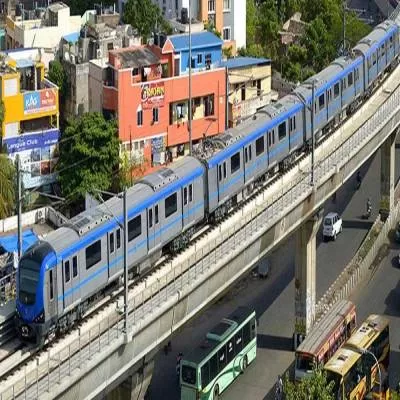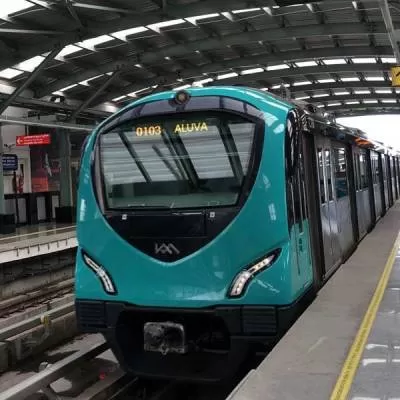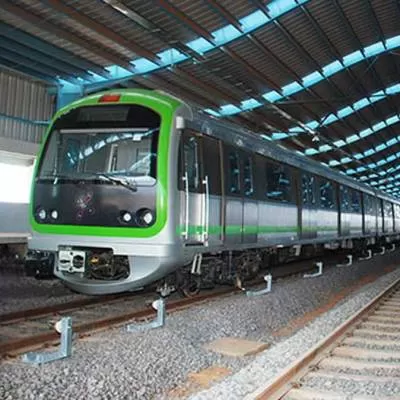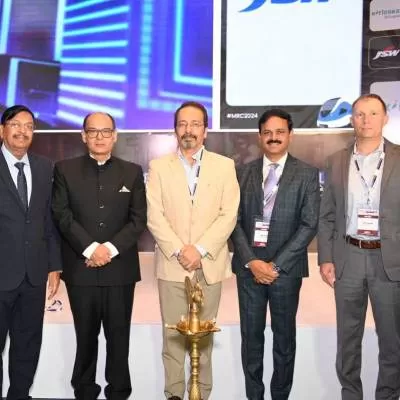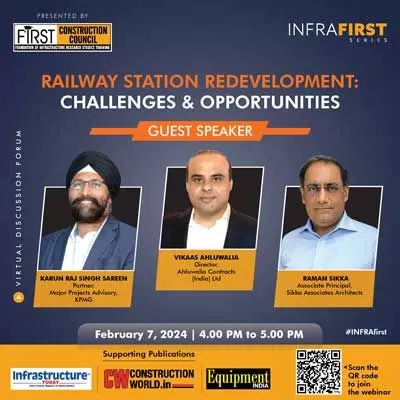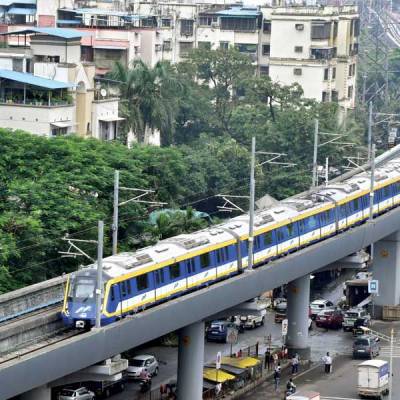- Home
- Infrastructure Transport
- RAILWAYS & METRO RAIL
- We have bid for various railway projects and are awaiting results for the same

We have bid for various railway projects and are awaiting results for the same
The nervous system of the rail network, signalling and telecommunications play a significant role in the Indian Railways. Here, speed and safety are crucial -this is what the VNR Group ensures. Among the leaders in this space, this Indian railway infrastructure and development company operates through two entities: Flagship VNR Infrastructures Ltd and VNR Rail Infrastructure Pvt Ltd. Under the leadership of V Narayana Reddy, Managing Director, the flagship company focuses on infrastructure contracting activities, while the second company focuses on BOT projects for the Indian Railways. Highlighting the company´s capability to handle large-scale railway signalling and infrastructure projects, Reddy shares more on the company´s plans and an industry perspective with CW.
VNR Group is involved in infrastructure development projects in the growing sectors of railways, irrigation, aviation, logistics and power. What is your current focus?
We are focused on developing our railway infrastructure portfolio as a sizeable portion of our revenue is derived from this segment.
Having specialised in railway infrastructure for the past 26 years, what are the challenges you face as a contractor?
Competitive bidding is a major challenge as it requires the bidders to qualify on certain technical parameters including past experience of executing projects of similar size. Further, timely execution of the project becomes a big challenge owing to various factors, such as approved plans and internal coordination among the departments of the railways.
The group´s core strength is technical competency for signalling and telecommunication in the Indian Railways. Kindly share some landmark projects executed by the company.
We have executed and commissioned signalling networks for several railway stations in India. Key projects include the installation of panel interlocking systems at 12 stations and interlocking of LC gates in the Khaitar-Jogbani section, Khaitar Division (Northern Frontier Railway). We have also been involved in installation, testing and commissioning of indoor and outdoor work with centralised panel operation of point and colour light signals with std III interlocking at Umed, Khariakhangar, Gotan, Jogimagara, Kheduli, Ren, Jalsu, Gachhi, Pura, Besroli, Borawar, Makrana stations, Jodhpur Division, North Western Railway. Another landmark project was the replacement of signalling gears by centralised operation of points and signals with electronic interlocking at Komatipalli, Donkinavalasa and Sitanagaram in RV line of WAT Division, East Cost Railway, and relay interlocking at Pakala, Damalcheruvu and Pulicherla stations, Guntakal Division, South Central Railway.
Apart from the green signal to the much-awaited bullet trains and 100-per-cent FDI in railways, excluding train operations and safety, the 2014 Railway Budget focused on greater efficiency. How do you perceive this?
There is a need to change railway planning and implementation policies; a business-friendly approach from the railway segment of India is missing. The FDI move will definitely help launch infrastructural development projects such as dedicated freight corridors, elevated rail corridors, high-speed rail systems, and port connectivity projects. Greater efficiency is always a welcome change.
At the policy level, what are the changes that could be brought about in this sector?
The present approach of planning, budgeting and monitoring works should considerably change. A time-bound approach should be adopted and delays in payments to contractors should be cut down.
How do you view opportunities in redevelopment of railway stations, metros and monorails?
The opportunities are huge and it is necessary to consider this either through PPP or EPC model by the Railways and the Planning Commission.
For large private players, the Indian Railways offers risk-free opportunities, which involve undertaking remunerative projects on EPC basis. What has VNR´s experience been on this front?
We have had a mixed experience; some rewarding and a few loss-making. Awarding of works is highly competitive and in this context the Railways should take a balanced view in arriving at quality work at reasonable cost. We are always exposed to the risks of price variation of raw material, equipment, and labour costs in fixed-price contracts as well as other factors that may increase our costs and, in turn, reduce our profits.
Seeking approvals from the Railways is one challenge. Can you elaborate on the exact situation? And with the new government coming in, how can this process be smoothened?
After the formation of RVNL by the Indian Railways, standalone projects like railway infra projects (earthwork, bridges, etc), signalling and telecommunication and overhead electrification were clubbed into one composite project by RVNL, a move that was appreciated. However, on the departmental and operational fronts at RVNL, the processes are the same as followed in the Indian Railways wherein even a composite project requires approval for standalone projects by the respective departments. This has led to delay in execution of projects thereby affecting the contractor´s performance. With the new government, we expect better synergies between departments.
In terms of technology, materials and construction equipment, what is your requirement?
In terms of technology, VNR has a long history of installation of all forms of signalling, which includes route relay interlocking, intermediate block sections, audio frequency track circuit, automatic signalling, electronic or solid state interlocking, block proving axle counter, optic fibre or quad cable works. In signalling and telecommunication projects, our job involves installing the devices sourced from OEM vendors certified by the Research Design & Standard Organisation (RDSO).
Is it correct to say that the Indian Railways contributes to as high as 80-85 per cent of VNR´s turnover?
This is subject to a variety of factors. We will need to wait and see how the sector evolves.
Please introduce us to challenging projects in your kitty.
VNR, along with consortium partners, has bagged one of the most prestigious rail projects in the country, a rail and road bridge over Brahmaputra River in Assam (Bogibeel Rail-Cum-Road Bridge Project). In the past, we have partnered with various Indian corporations for bidding and executing projects. At present, we have bid for various railway projects and are awaiting results for the same.
FACT SHEET
Year of establishment: Established as proprietor firm; later acquired by VNR Infrastructures Ltd, a public limited company, which was incorporated in November 2005 Top management: Vakati Narayana Reddy, Managing Director; Governed by board of directors and key management employees Areas of expertise: Signalling and telecommunication projects for Railways involving panel interlocking, route relay interlocking, electronic or solid state interlocking, intermediate block sections, optic fibre or quad cable works, audio frequency track circuit, automatic signalling, block proving with axle counter, signalling for level crossing gates; executing railway infrastructure projects comprising of earthwork, track laying, all type of bridges, passenger amenities, etc.
Suggestions on contractors to be covered? Write in at feedback@ASAPPmedia.com
- V Narayana Reddy, Managing Director, VNR Infrastructures Ltd The nervous system of the rail network, signalling and telecommunications play a significant role in the Indian Railways. Here, speed and safety are crucial -this is what the VNR Group ensures. Among the leaders in this space, this Indian railway infrastructure and development company operates through two entities: Flagship VNR Infrastructures Ltd and VNR Rail Infrastructure Pvt Ltd. Under the leadership of V Narayana Reddy, Managing Director, the flagship company focuses on infrastructure contracting activities, while the second company focuses on BOT projects for the Indian Railways. Highlighting the company´s capability to handle large-scale railway signalling and infrastructure projects, Reddy shares more on the company´s plans and an industry perspective with CW. VNR Group is involved in infrastructure development projects in the growing sectors of railways, irrigation, aviation, logistics and power. What is your current focus? We are focused on developing our railway infrastructure portfolio as a sizeable portion of our revenue is derived from this segment. Having specialised in railway infrastructure for the past 26 years, what are the challenges you face as a contractor? Competitive bidding is a major challenge as it requires the bidders to qualify on certain technical parameters including past experience of executing projects of similar size. Further, timely execution of the project becomes a big challenge owing to various factors, such as approved plans and internal coordination among the departments of the railways. The group´s core strength is technical competency for signalling and telecommunication in the Indian Railways. Kindly share some landmark projects executed by the company. We have executed and commissioned signalling networks for several railway stations in India. Key projects include the installation of panel interlocking systems at 12 stations and interlocking of LC gates in the Khaitar-Jogbani section, Khaitar Division (Northern Frontier Railway). We have also been involved in installation, testing and commissioning of indoor and outdoor work with centralised panel operation of point and colour light signals with std III interlocking at Umed, Khariakhangar, Gotan, Jogimagara, Kheduli, Ren, Jalsu, Gachhi, Pura, Besroli, Borawar, Makrana stations, Jodhpur Division, North Western Railway. Another landmark project was the replacement of signalling gears by centralised operation of points and signals with electronic interlocking at Komatipalli, Donkinavalasa and Sitanagaram in RV line of WAT Division, East Cost Railway, and relay interlocking at Pakala, Damalcheruvu and Pulicherla stations, Guntakal Division, South Central Railway. Apart from the green signal to the much-awaited bullet trains and 100-per-cent FDI in railways, excluding train operations and safety, the 2014 Railway Budget focused on greater efficiency. How do you perceive this? There is a need to change railway planning and implementation policies; a business-friendly approach from the railway segment of India is missing. The FDI move will definitely help launch infrastructural development projects such as dedicated freight corridors, elevated rail corridors, high-speed rail systems, and port connectivity projects. Greater efficiency is always a welcome change. At the policy level, what are the changes that could be brought about in this sector? The present approach of planning, budgeting and monitoring works should considerably change. A time-bound approach should be adopted and delays in payments to contractors should be cut down. How do you view opportunities in redevelopment of railway stations, metros and monorails? The opportunities are huge and it is necessary to consider this either through PPP or EPC model by the Railways and the Planning Commission. For large private players, the Indian Railways offers risk-free opportunities, which involve undertaking remunerative projects on EPC basis. What has VNR´s experience been on this front? We have had a mixed experience; some rewarding and a few loss-making. Awarding of works is highly competitive and in this context the Railways should take a balanced view in arriving at quality work at reasonable cost. We are always exposed to the risks of price variation of raw material, equipment, and labour costs in fixed-price contracts as well as other factors that may increase our costs and, in turn, reduce our profits. Seeking approvals from the Railways is one challenge. Can you elaborate on the exact situation? And with the new government coming in, how can this process be smoothened? After the formation of RVNL by the Indian Railways, standalone projects like railway infra projects (earthwork, bridges, etc), signalling and telecommunication and overhead electrification were clubbed into one composite project by RVNL, a move that was appreciated. However, on the departmental and operational fronts at RVNL, the processes are the same as followed in the Indian Railways wherein even a composite project requires approval for standalone projects by the respective departments. This has led to delay in execution of projects thereby affecting the contractor´s performance. With the new government, we expect better synergies between departments. In terms of technology, materials and construction equipment, what is your requirement? In terms of technology, VNR has a long history of installation of all forms of signalling, which includes route relay interlocking, intermediate block sections, audio frequency track circuit, automatic signalling, electronic or solid state interlocking, block proving axle counter, optic fibre or quad cable works. In signalling and telecommunication projects, our job involves installing the devices sourced from OEM vendors certified by the Research Design & Standard Organisation (RDSO). Is it correct to say that the Indian Railways contributes to as high as 80-85 per cent of VNR´s turnover? This is subject to a variety of factors. We will need to wait and see how the sector evolves. Please introduce us to challenging projects in your kitty. VNR, along with consortium partners, has bagged one of the most prestigious rail projects in the country, a rail and road bridge over Brahmaputra River in Assam (Bogibeel Rail-Cum-Road Bridge Project). In the past, we have partnered with various Indian corporations for bidding and executing projects. At present, we have bid for various railway projects and are awaiting results for the same. FACT SHEET Year of establishment: Established as proprietor firm; later acquired by VNR Infrastructures Ltd, a public limited company, which was incorporated in November 2005 Top management: Vakati Narayana Reddy, Managing Director; Governed by board of directors and key management employees Areas of expertise: Signalling and telecommunication projects for Railways involving panel interlocking, route relay interlocking, electronic or solid state interlocking, intermediate block sections, optic fibre or quad cable works, audio frequency track circuit, automatic signalling, block proving with axle counter, signalling for level crossing gates; executing railway infrastructure projects comprising of earthwork, track laying, all type of bridges, passenger amenities, etc. Suggestions on contractors to be covered? Write in at feedback@ASAPPmedia.com


